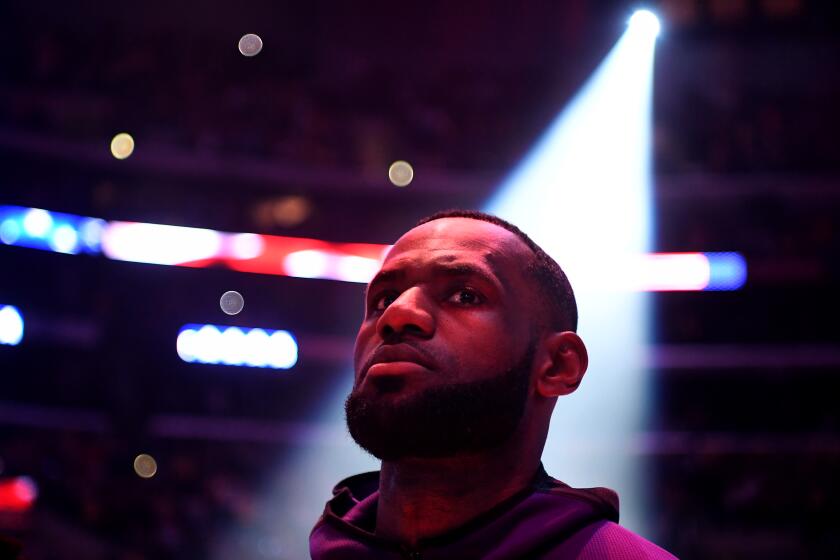Column: It’s hard to believe, but Mike Trout is still getting better
- Share via
Are you superstitious?
Mike Trout glanced up.
“Yeah,” he said.
He smiled.
“What’s the question about?” Trout said. “Hitting?”
Trout homered in each of the last three games leading into the Angels’ series opener Monday night against the Chicago White Sox. So, yeah, hitting.
“Yeah, no,” he said.
Trout chuckled and bolted into the part of the Angels’ clubhouse closed to reporters.
Oh, well.
Several seconds later, Trout returned to his locker, still smiling.
“I’m messing with you,” he said. “Whatcha got?”
Of course Mike Trout isn’t superstitious.
He has been widely recognized as the best player in baseball for the last five years. Each of his seasons has been some variation of awesome and he’s playing better now than ever.
A few hours after talking about his improved production, Trout launched his 12th home run, extending his home run streak to a career-long four games. The last Angels player to homer in four consecutive games was Mark Trumbo, in 2012.
“Even though it sounds strange, it looks like he’s doing things easier,” manager Mike Scioscia said.
If you haven’t noticed what Trout has been doing in Anaheim, you’re not alone. Again hamstrung by injuries and the absence of frontline starting pitchers, the Angels are floundering around .500 and back in the role of regional afterthoughts. Angel Stadium was more than half-empty Monday night.
But the price of ignoring the Angels is missing out on Trout, who, at 25, could be a quarter of the way into the best season of his already-historic career.
He is on pace for 47 home runs. His single-season best of 41 was set in 2015.
He entered Monday batting .352, a career high. His previous best was .326, as a rookie in 2012.
His on-base percentage was .449, better than the .441 he recorded last year.
On-base-plus-slugging percentage? Also a career high, at a Babe Ruth-like 1.187. His OPS in each of the last two seasons was .991.
Some players around the league have said they have consciously tried to hit more home runs by adjusting the launch angles of their batted balls, which is information now widely available to players. Trout isn’t one of them.
“I don’t look at that stuff,” he said. “My thing is barrel up the baseball, if it goes over the fence, it goes over the fence.”
He also doesn’t have much use for studying video of opposing pitchers. “I like to be simple,” he said.
Of the chance he has of hitting 40 home runs and stealing 40 bases in the same season, Trout said, “It’d definitely be a cool statistic. But I don’t really set individual numbers. You can’t control home runs. If I try to hit home runs every time, I’m going to get out every time.”
While his immediate success has obscured the extent of his growth, a close observer such as Scioscia can point to how Trout has evolved as a player.
“You’re 19 years old, I don’t care how good you are, you’re not the finished product,” Scioscia said. “I think experience is the best teacher and he’s used his experience extremely well. He’s made adjustments along the way.”
Trout has gradually become more aggressive.
Two years ago, he swung at only 10.2% of first pitches, according to Baseball Reference. This season, that number was up to 24.5% through Sunday.
“He’s definitely made adjustments to where he was a couple of years ago, where he was very, very passive early in counts,” Scioscia said.
Trout was productive back then, too. That was one of the three seasons in which he was the runner-up for the American League MVP award. He finished first in his other two seasons.
“It worked both ways, but it’s an adjustment that I know he was comfortable with and it’s led to pitchers having to do some different things that probably led to better counts for him in the course of an at-bat,” Scioscia said. “I think it’s a good thing when you’re able to have the plate discipline that Mike has when you’re able to do that. A lot of guys try to be more aggressive and it’s counterproductive because they’re going to start to expand a little early in counts and get into counts they shouldn’t be in.”
Trout has somehow not only become more aggressive, he also has become more selective.
He has swung at a career-low 21.7% of pitches outside the strike zone, down from 23.0% last year, according to FanGraphs. He has swung at a career-high 70.5% of pitches in the zone, up from his previous best of 60.3% last year.
Trout pointed to his experience as the reason.
“You see the pitchers more often,” Trout said. “Over the five or six years, you get to see pitchers more often and see their tendencies.”
Scary words for opposing pitchers.
Follow Dylan Hernandez on Twitter @dylanohernandez
More to Read
Go beyond the scoreboard
Get the latest on L.A.'s teams in the daily Sports Report newsletter.
You may occasionally receive promotional content from the Los Angeles Times.










